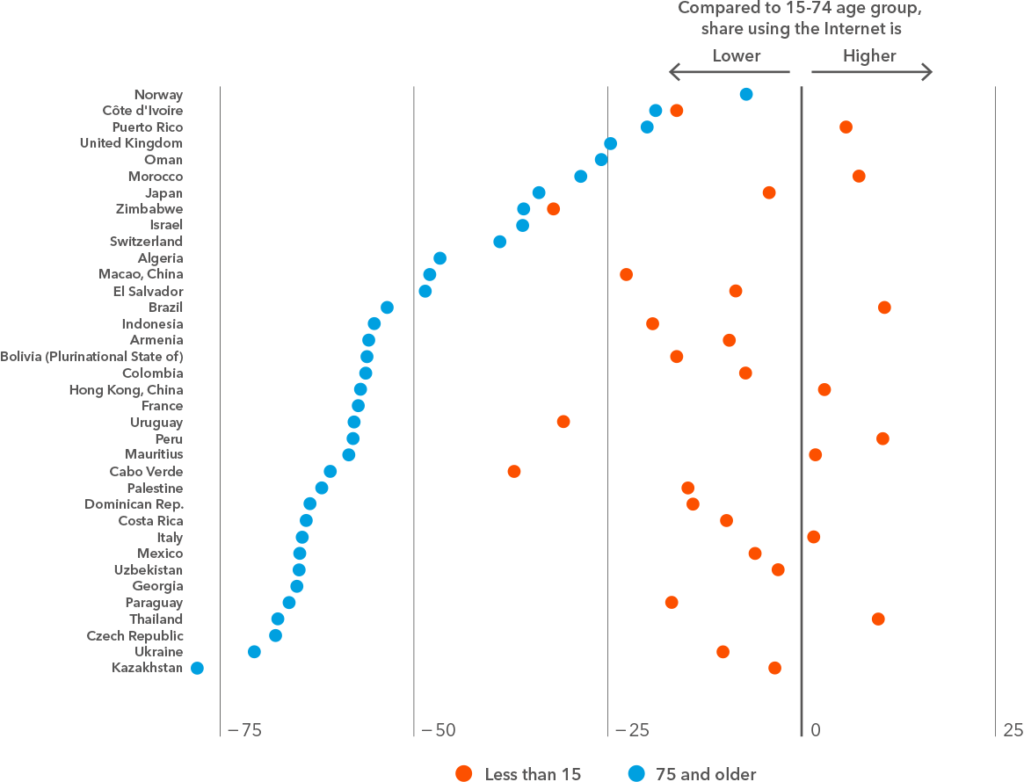This chapter explores options to accelerate progress towards universal and meaningful connectivity. Expanding broadband networks is needed to eliminate the remaining blind spots and improve the quality of connectivity. Measures include reducing constraints on foreign direct investment to attract capital for upgrading and expanding digital infrastructure; ensuring sound ICT sector regulation to help build competitive markets and enhance predictability; promoting infrastructure sharing to reduce costs; ensuring the supply of adequate, inexpensive spectrum to help reduce coverage gaps; and ensuring sufficient capacity and a shift to new generations of mobile broadband.
Solutions to ensure an adequate energy provision to power ICT infrastructure include policy incentives, reducing duties and taxes on green power equipment and allowing independent power producers. Recalibrating universal service funds (USFs) can help deployment of infrastructure in unserved areas to reduce gaps among vulnerable groups such as women and girls, persons with disabilities and older persons.
The inter-generational gap in Internet use
Percentage point difference to share of 15–74-year-olds using the Internet, by age group (2018 or later)

Source: ITU
Overcoming digital illiteracy is critical in bridging the usage gap. Effective and large-scale programmes are needed to address the challenge, including providing digital literacy as part of the school curriculum. Funding school connectivity remains a challenge, however. In many low- and middle-income countries where equipping schools with electricity is already a struggle, Internet access and digital skills are often after-thoughts. The cost of devices and Internet service is a significant barrier that stops many people from using the Internet. Countries have limited options, but eliminating import duties and reducing taxes on services will make them more affordable. Governments should encourage operators to offer a variety of plans that cater to different income levels and circumstances. Other measures to improve affordability include the provision of unlimited broadband access to community centres and schools; maintaining the temporary COVID-19 concessions that were put in place by operators in many countries; subsidizing data use for the poorest; and applying zero ratings for critical services such as e-government, education and health sites.
Meaningful connectivity implies safety of use. Threats include a breach of data privacy, misinformation and harmful content, and overuse of digital technology. It is important to know how to mitigate risks to preserve trust in the use of the Internet. Countries need to enact better data protection laws to safeguard privacy, social media companies need to moderate content to detect false and inciteful content, and media literacy must be part of any digital skills training.
To achieve universal connectivity, disadvantaged groups such as women and girls, persons with disabilities, older persons, those with low incomes and people living in remote areas, require special attention. Greater collaboration is needed across governments, agencies, advocacy organizations and digital companies to accelerate the acquisition of digital skills. To reduce the gender gap, non-governmental organizations should be supported in providing mentoring and digital skills training for women and girls. Technology companies, too, can play a role, not only by supporting skills initiatives but also by setting their own gender equity targets. Digital products and services should be customized to the needs of women in terms of design, safety and security. Training of older persons is necessary if they are to access online public services. Measures to reduce the digital disability gap include raising awareness, enacting laws that require online public services to be accessible to persons with disabilities, adapting products by adhering to international design guidelines, and supporting entrepreneurs in the development of contextually relevant digital assistive technologies. Since data are often lacking, there is a need to ensure that the scope of ICT surveys addresses disadvantaged groups as well.
Among the challenges posed by increased digital connectivity, e-waste continues to grow, and what happens to over four-fifths of e-waste is unknown. As a minimum, the recycling process should be made easier for consumers. Connectivity will help reduce carbon emissions across the economy, for example video conferencing for work and education will reduce travel while the greater use of sensors will generate energy efficiencies across many sectors. Furthermore, there is considerable untapped renewable potential from solar, wind, hydro and geothermal sources in many low- and middle-income countries. As major energy users, ICT companies can provide the scale of investment to make renewable energy economically feasible. Governments can help enormously by creating climate friendly energy strategies and liberalizing markets, particularly by welcoming independent renewable power producers.